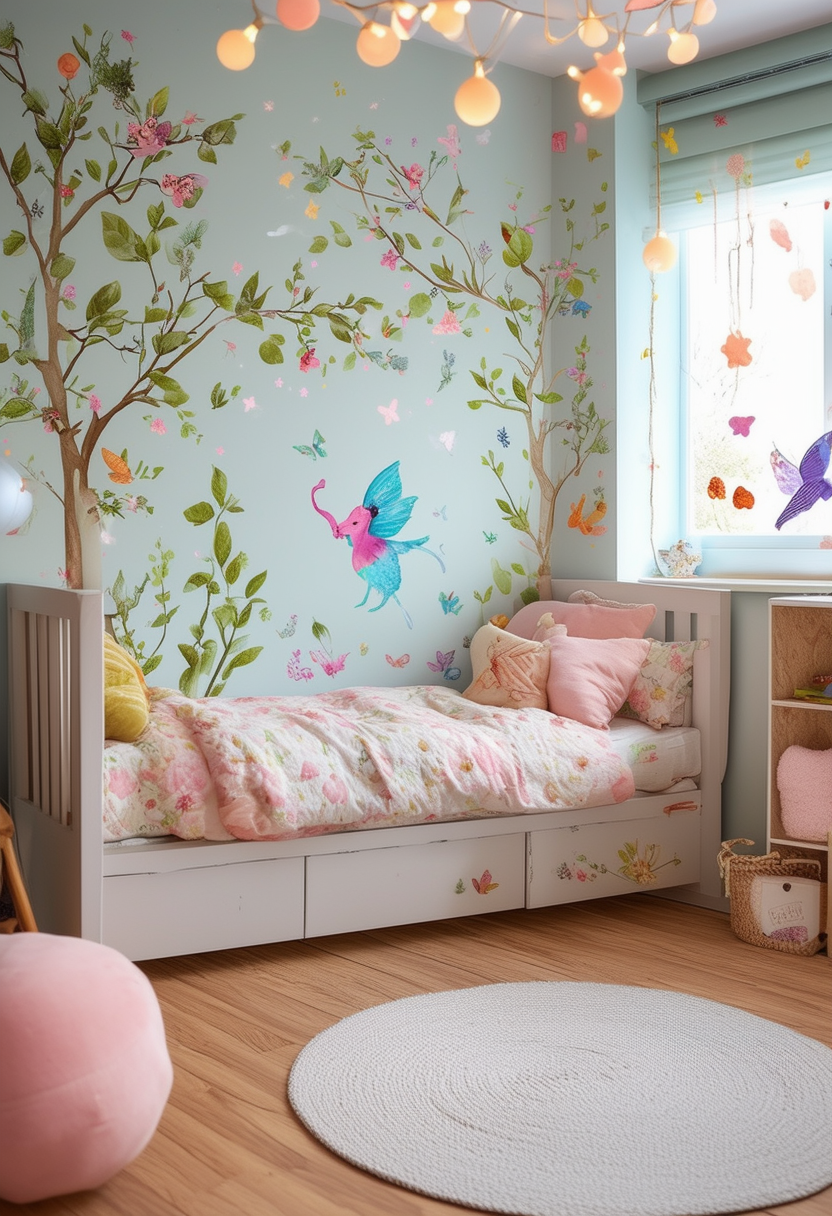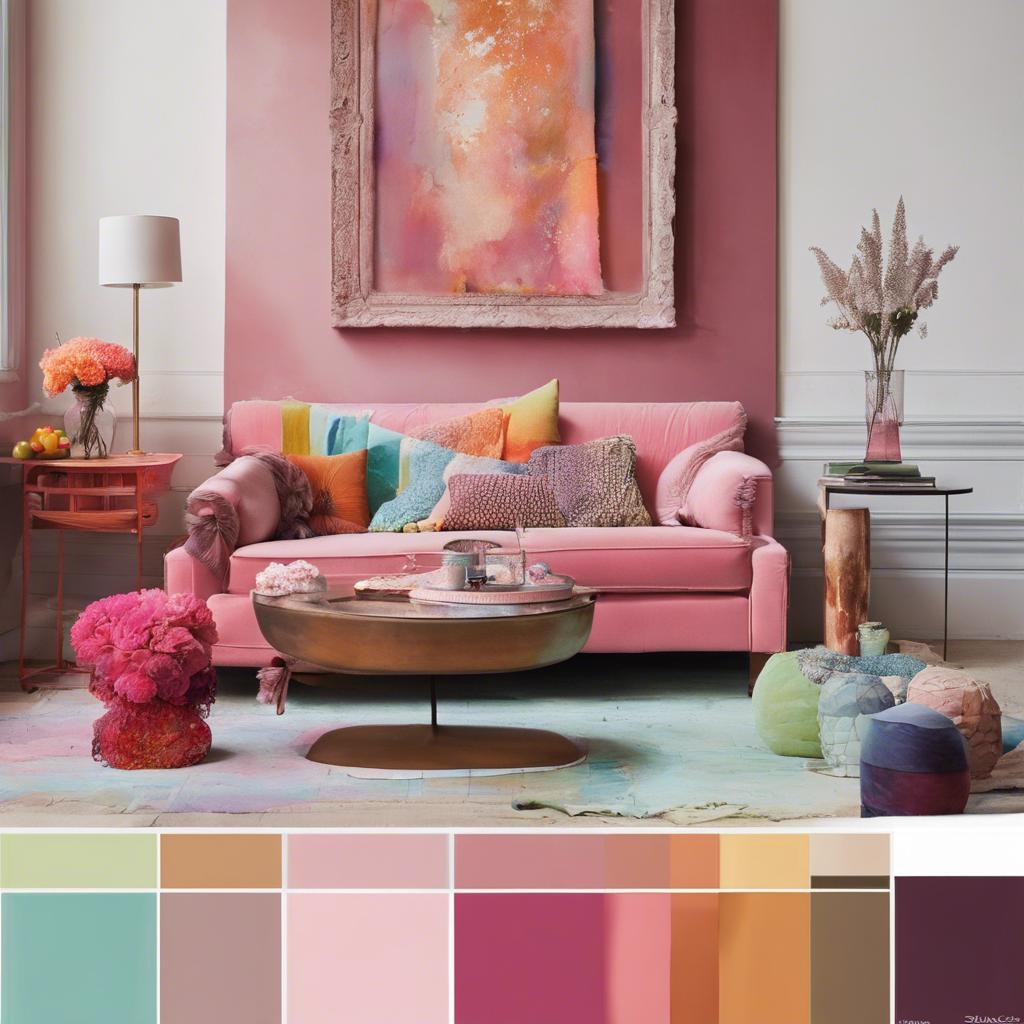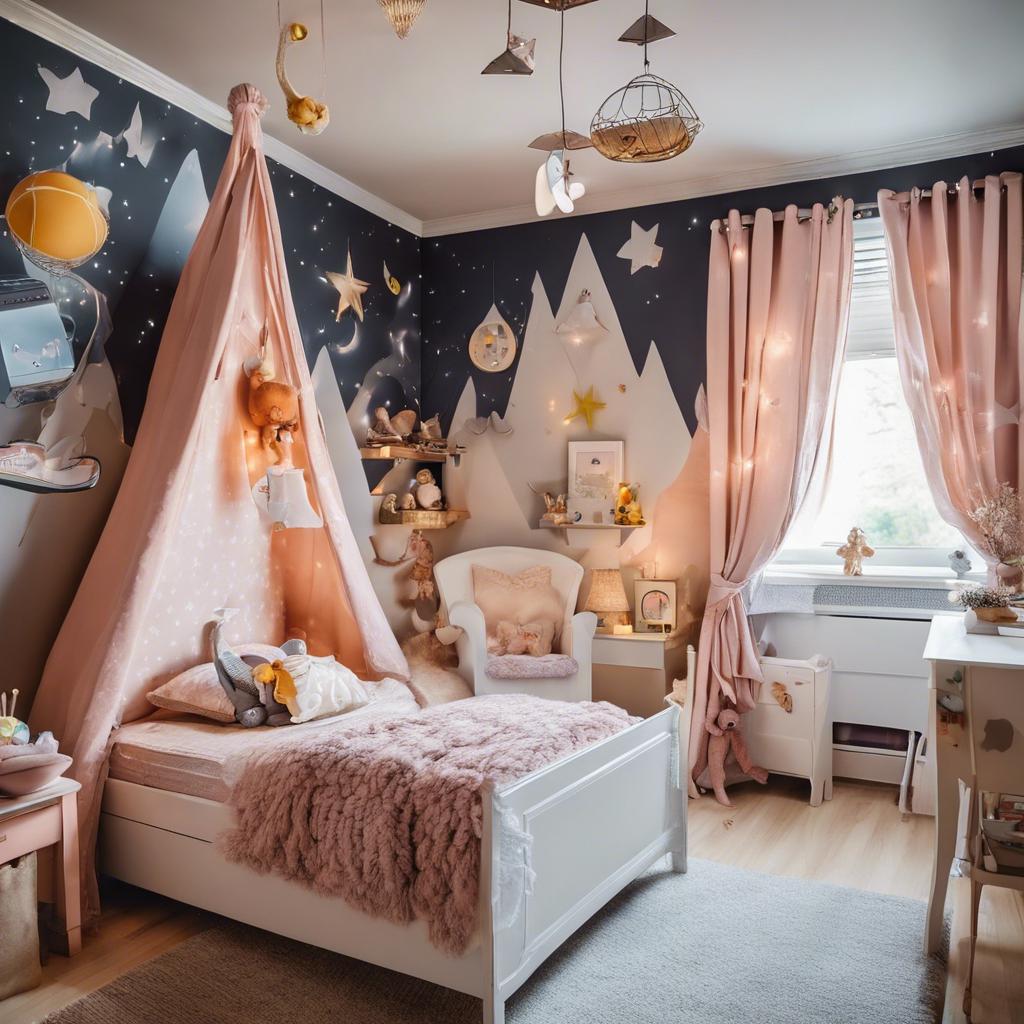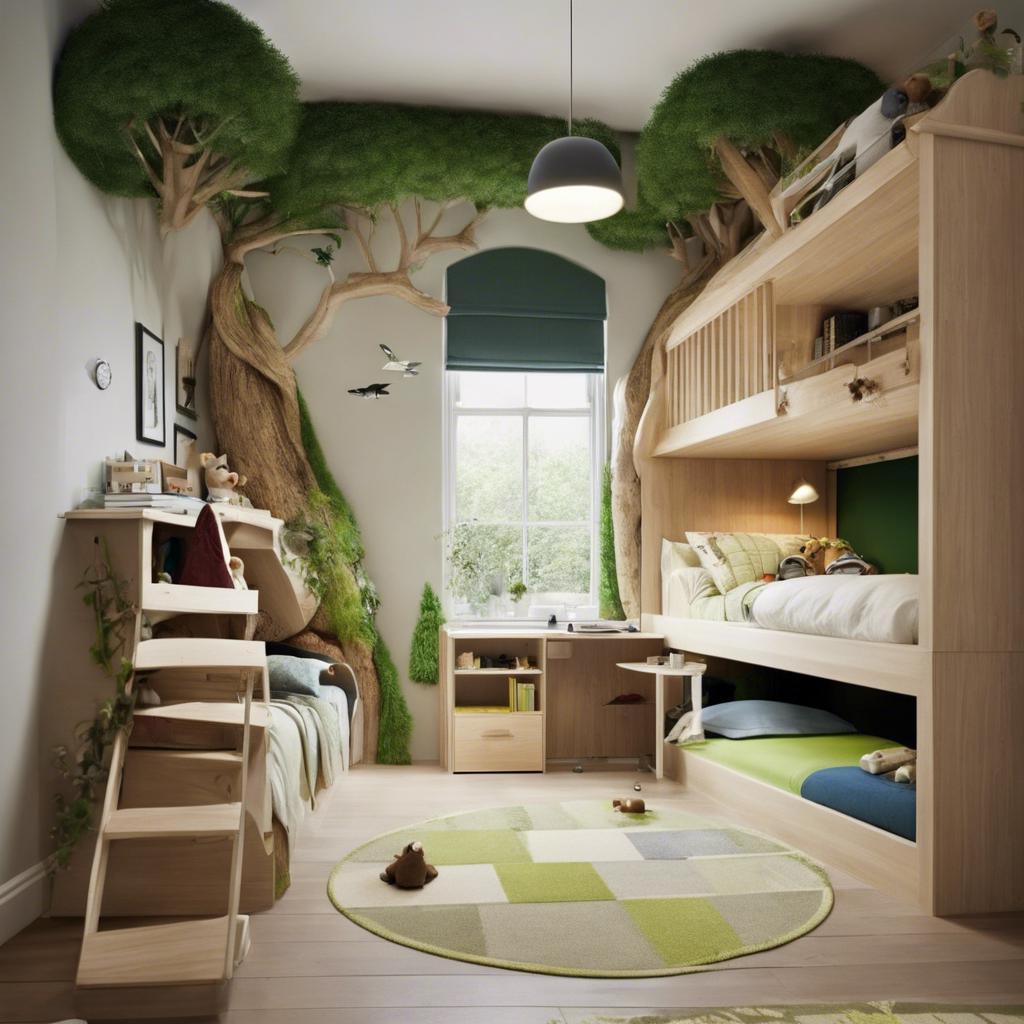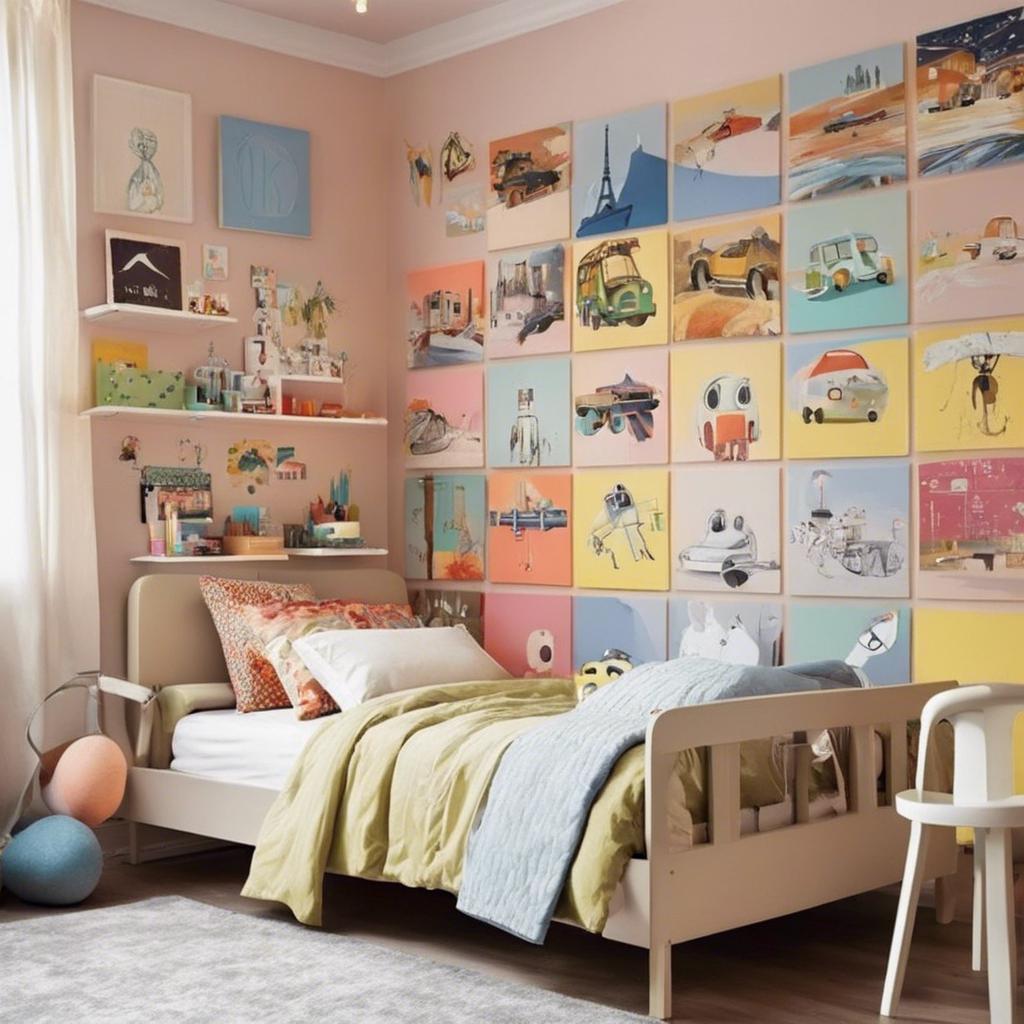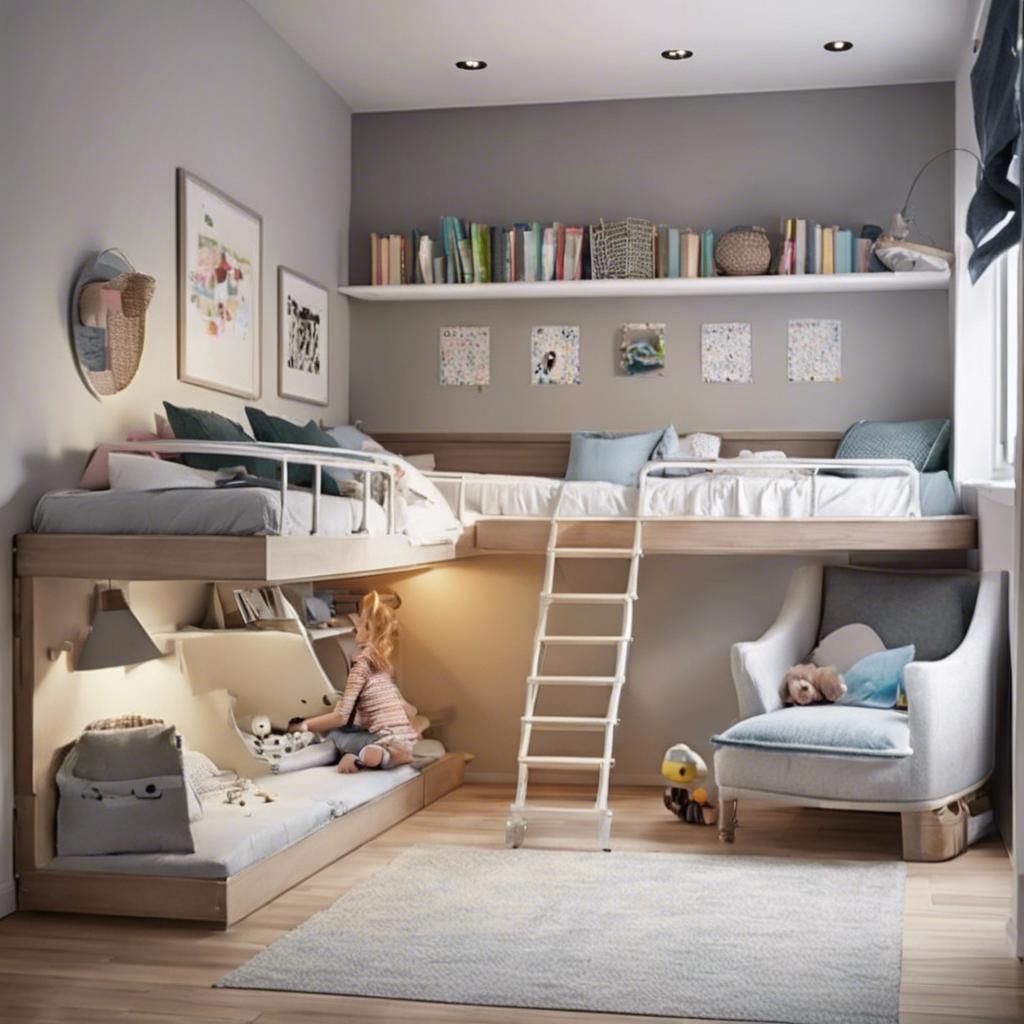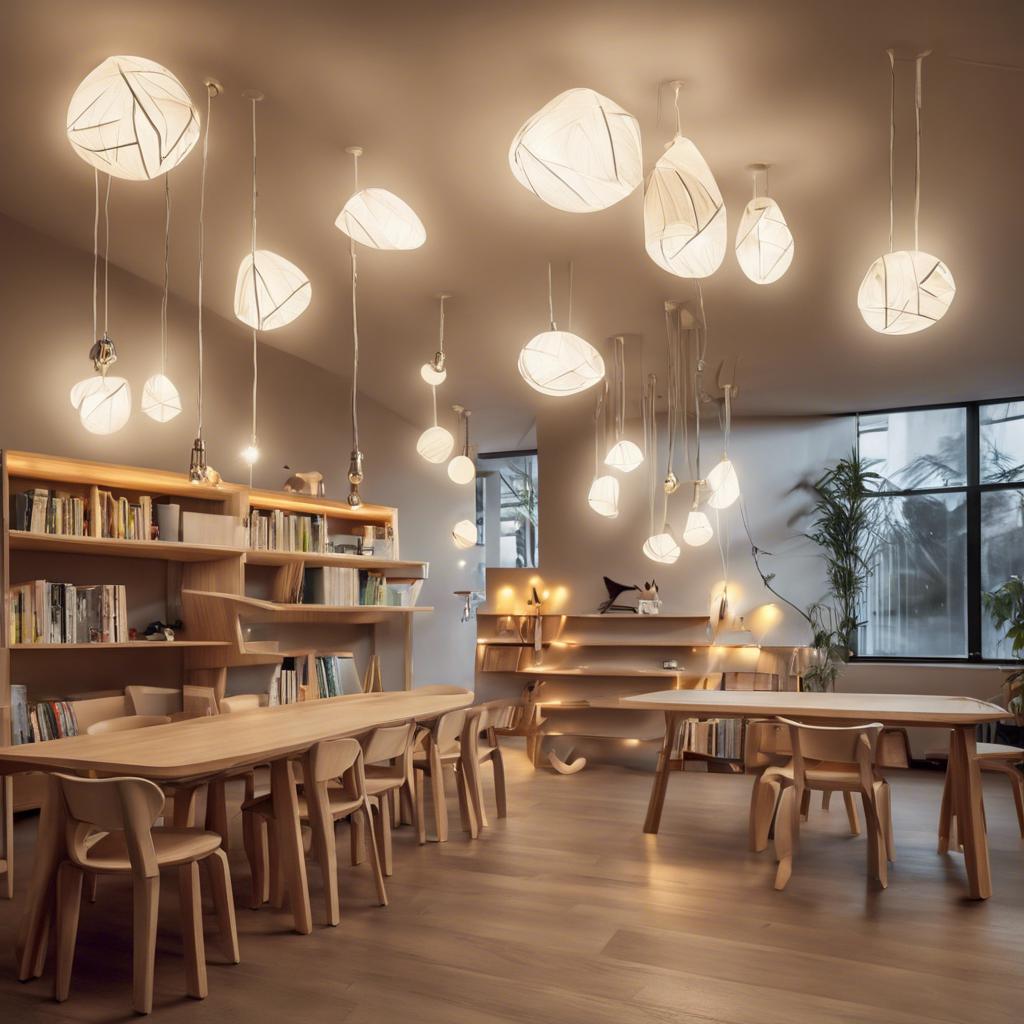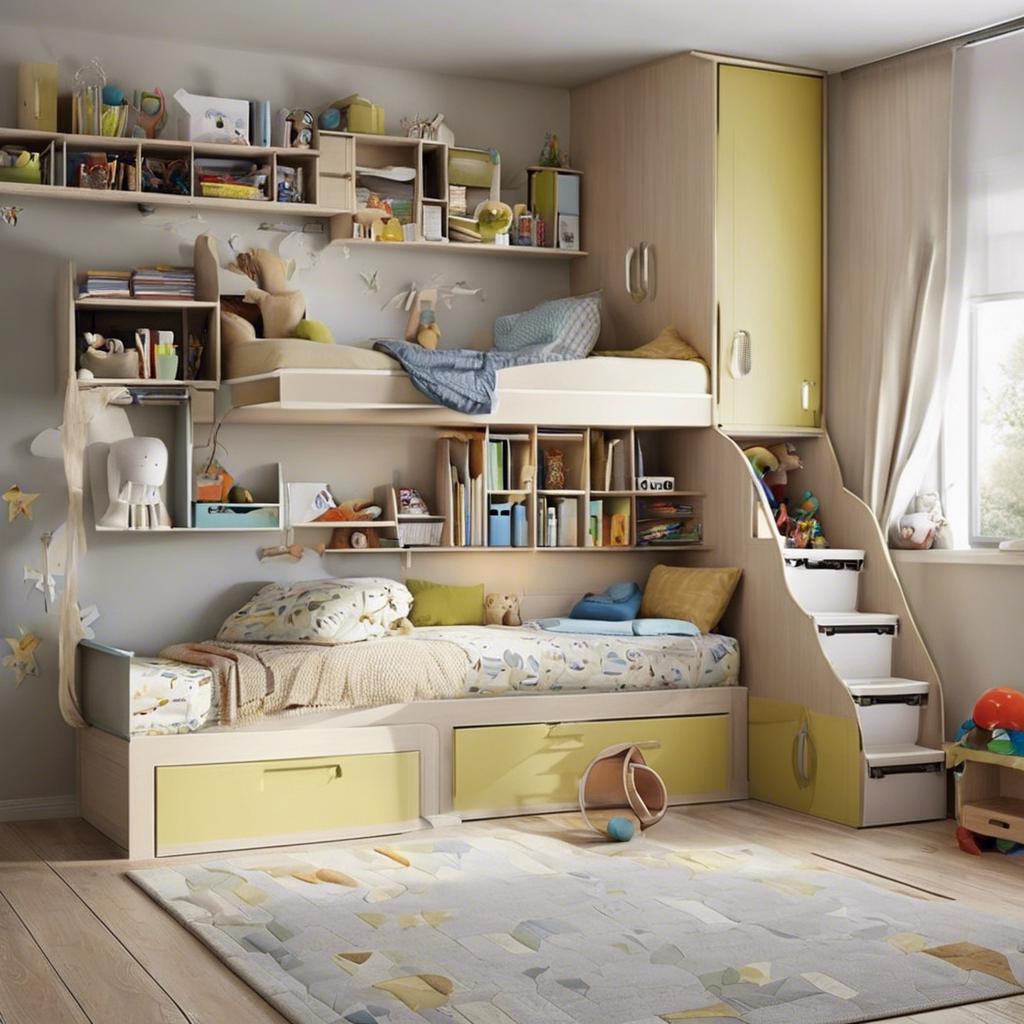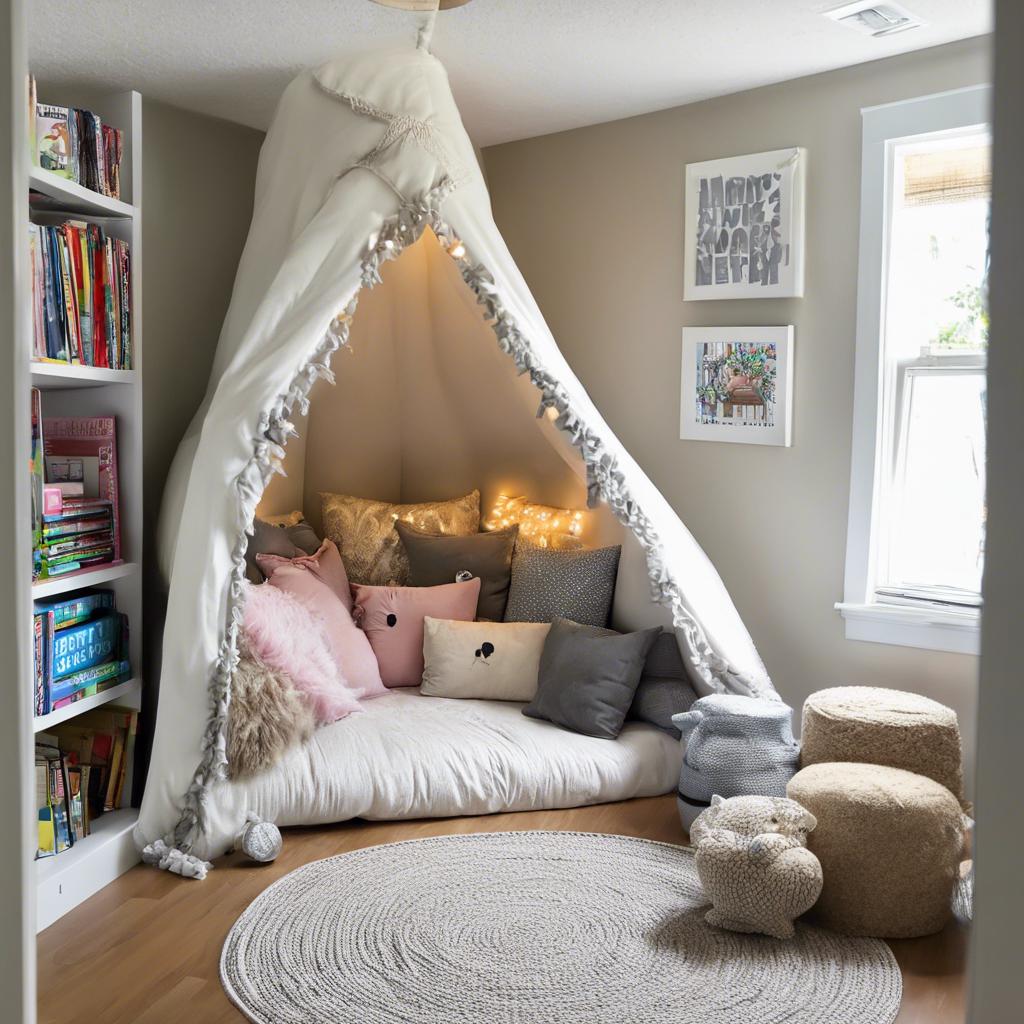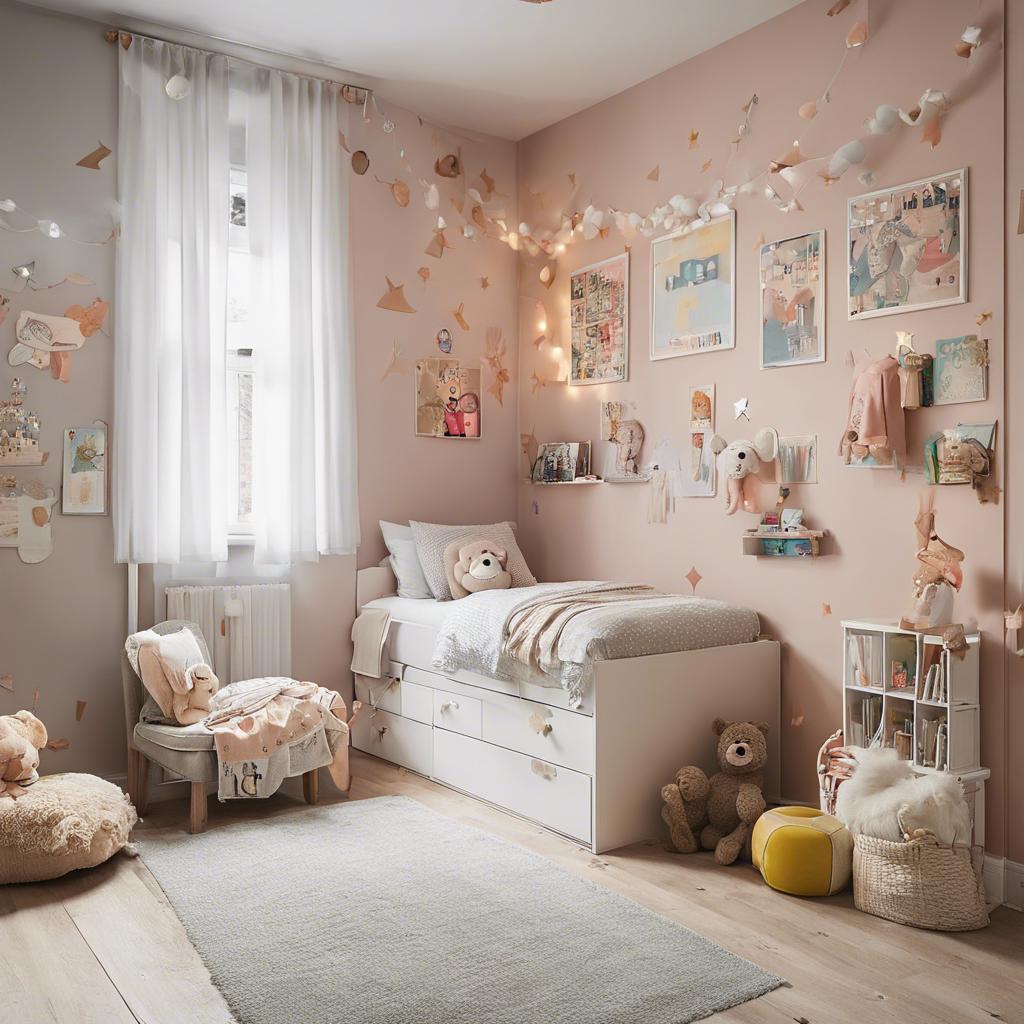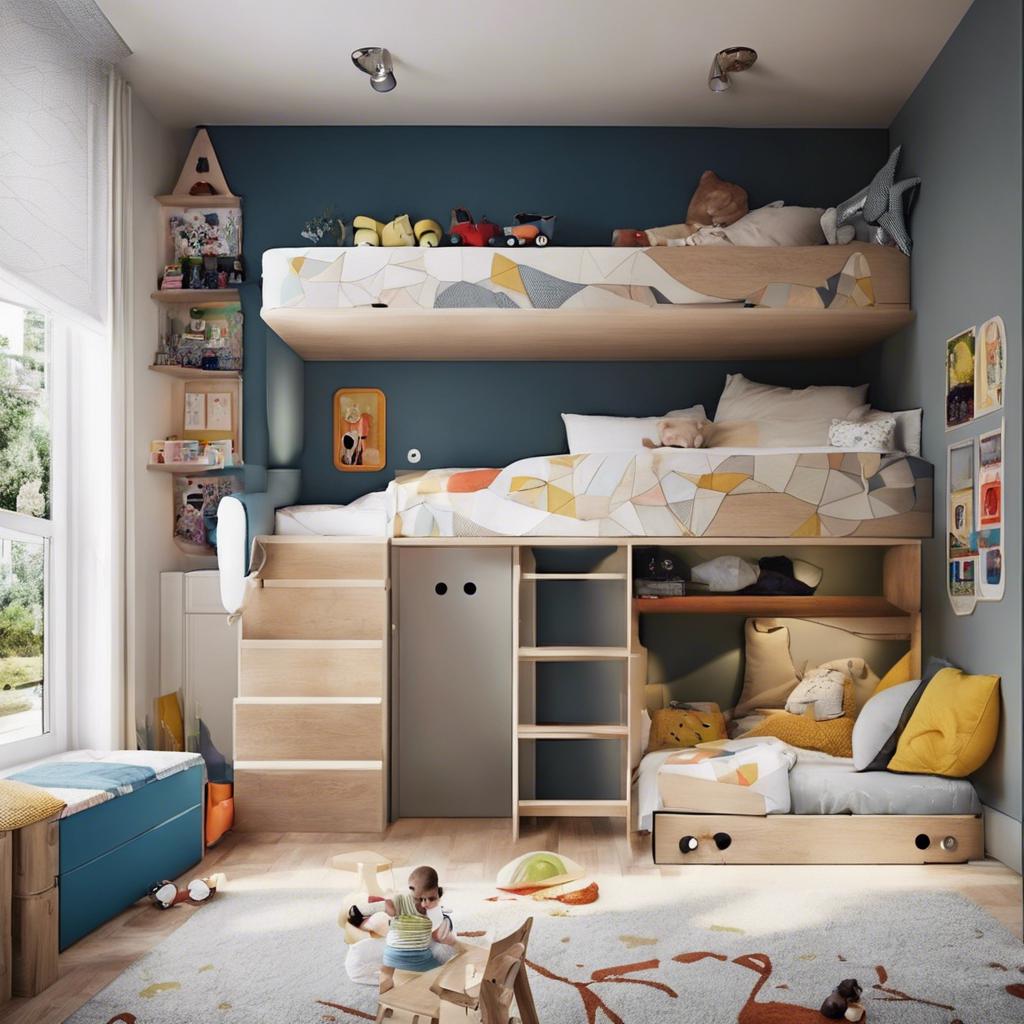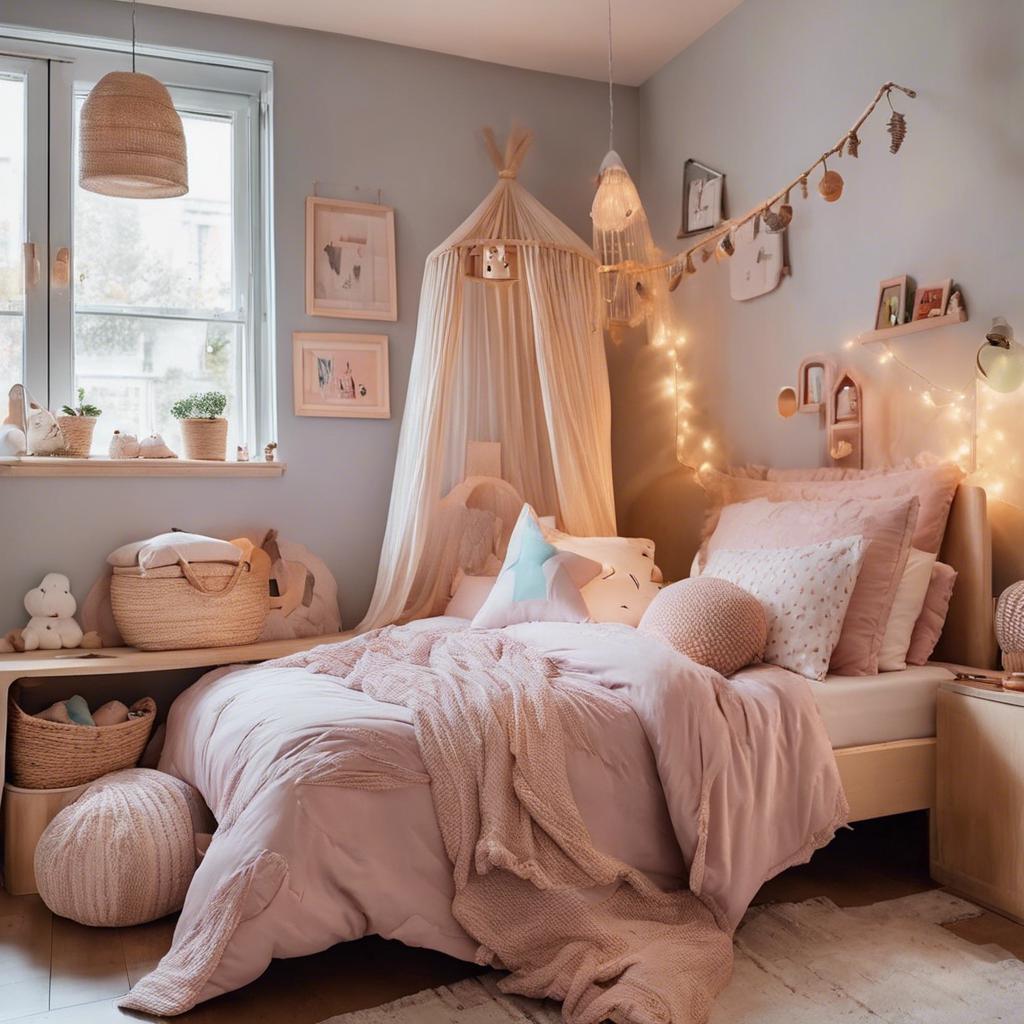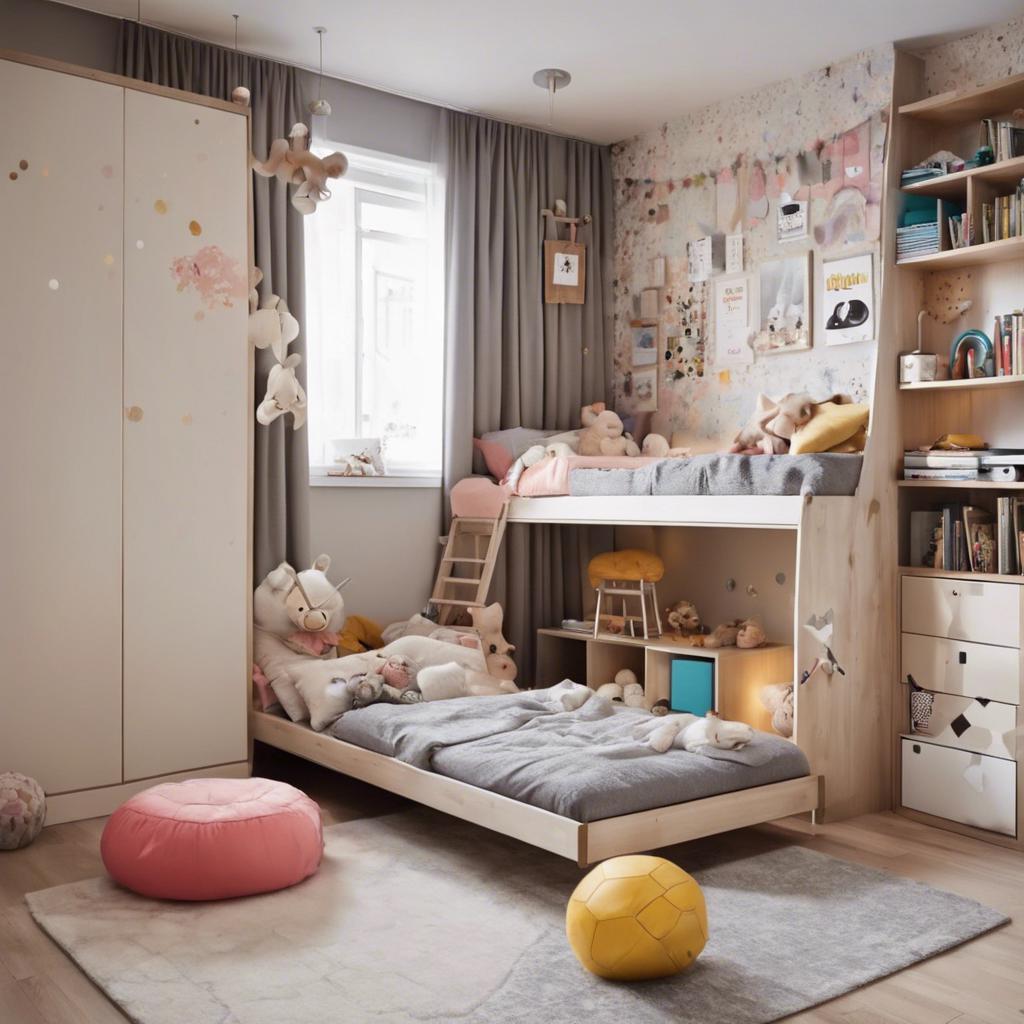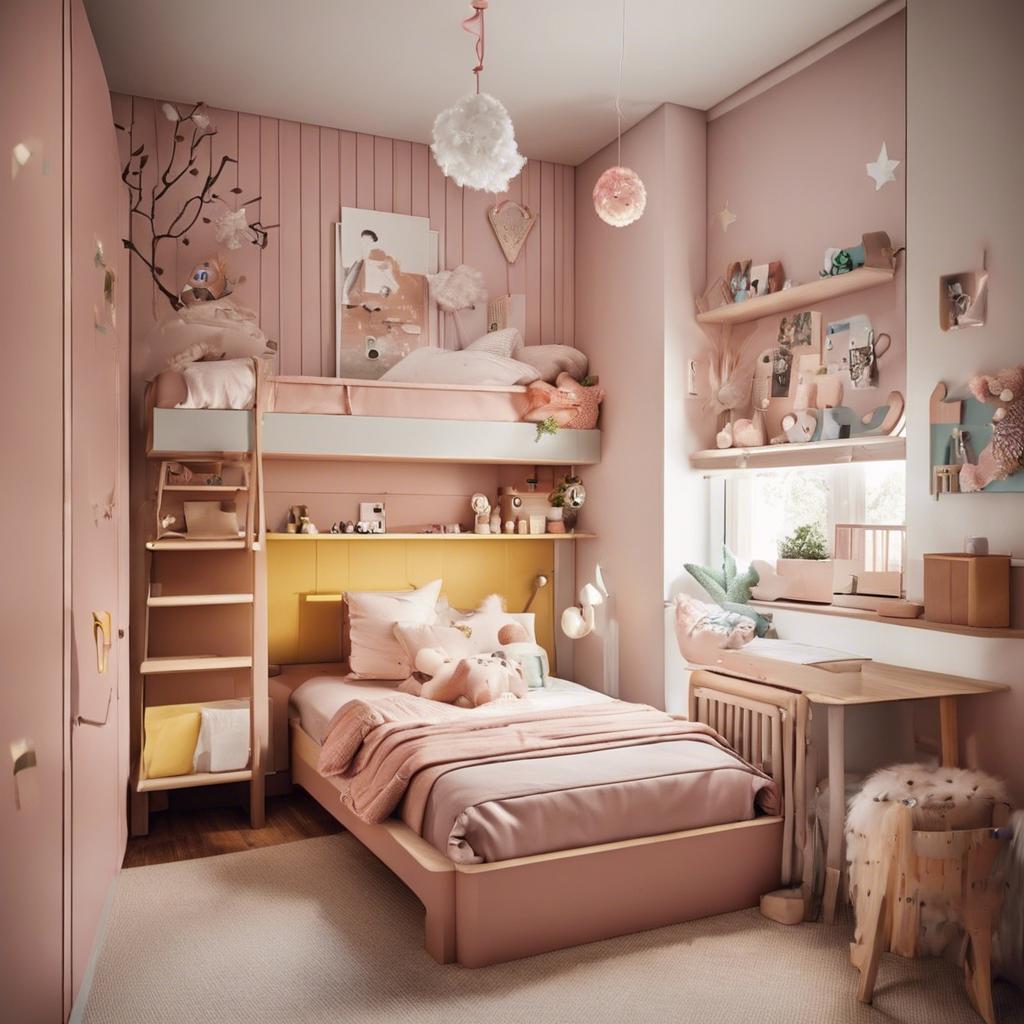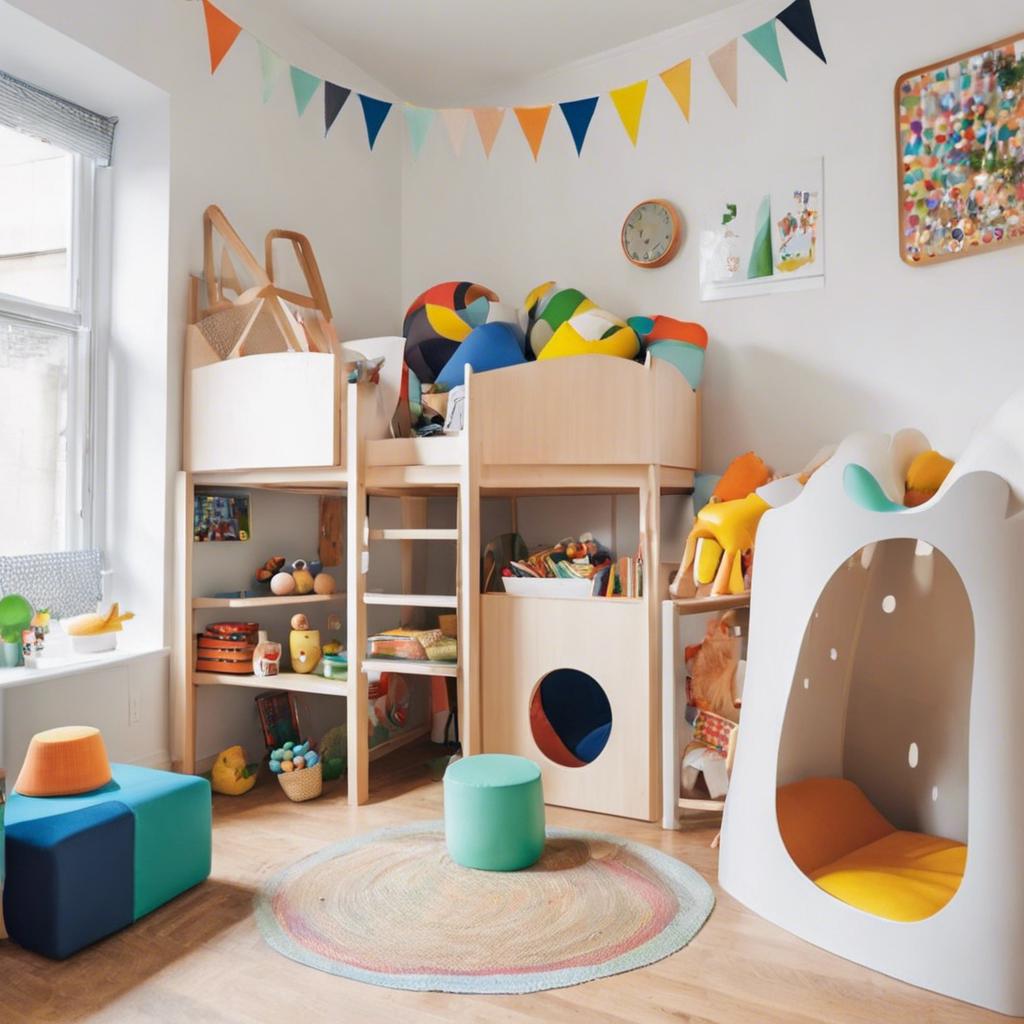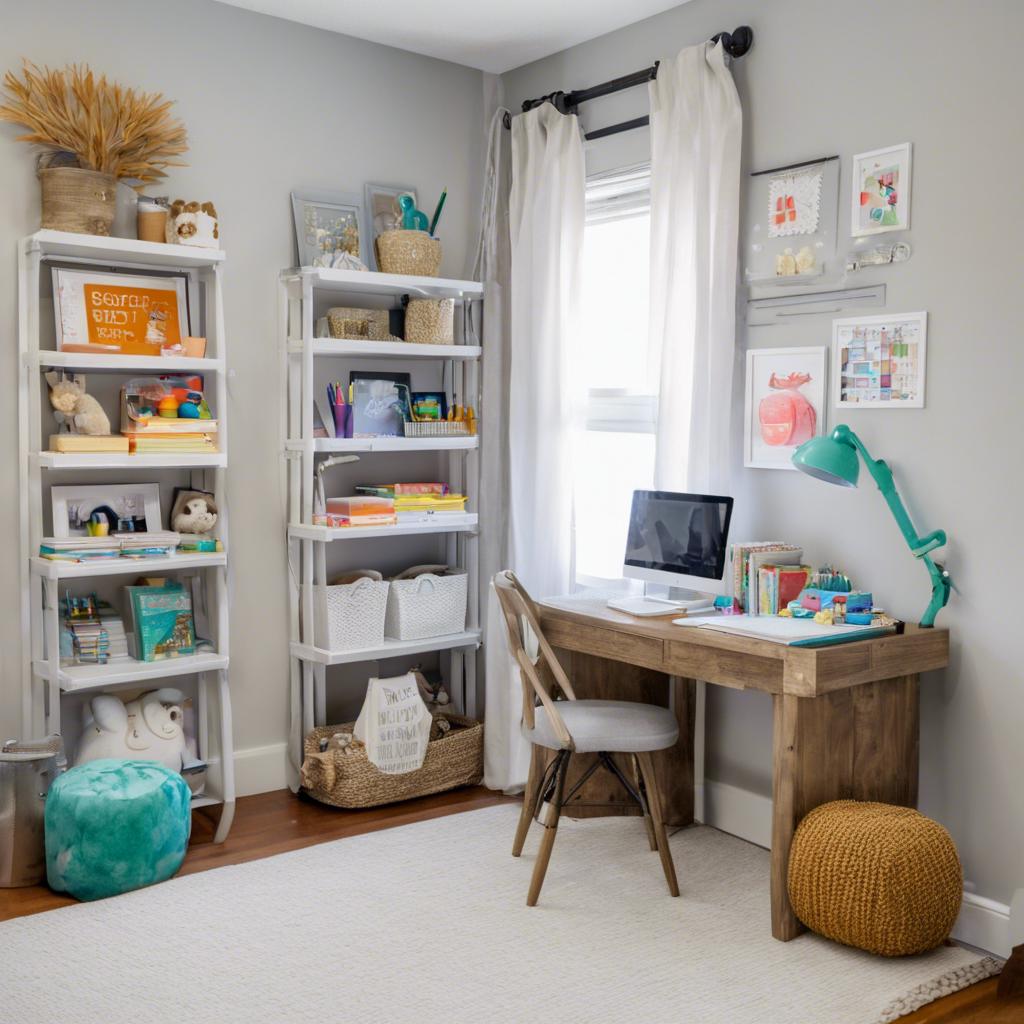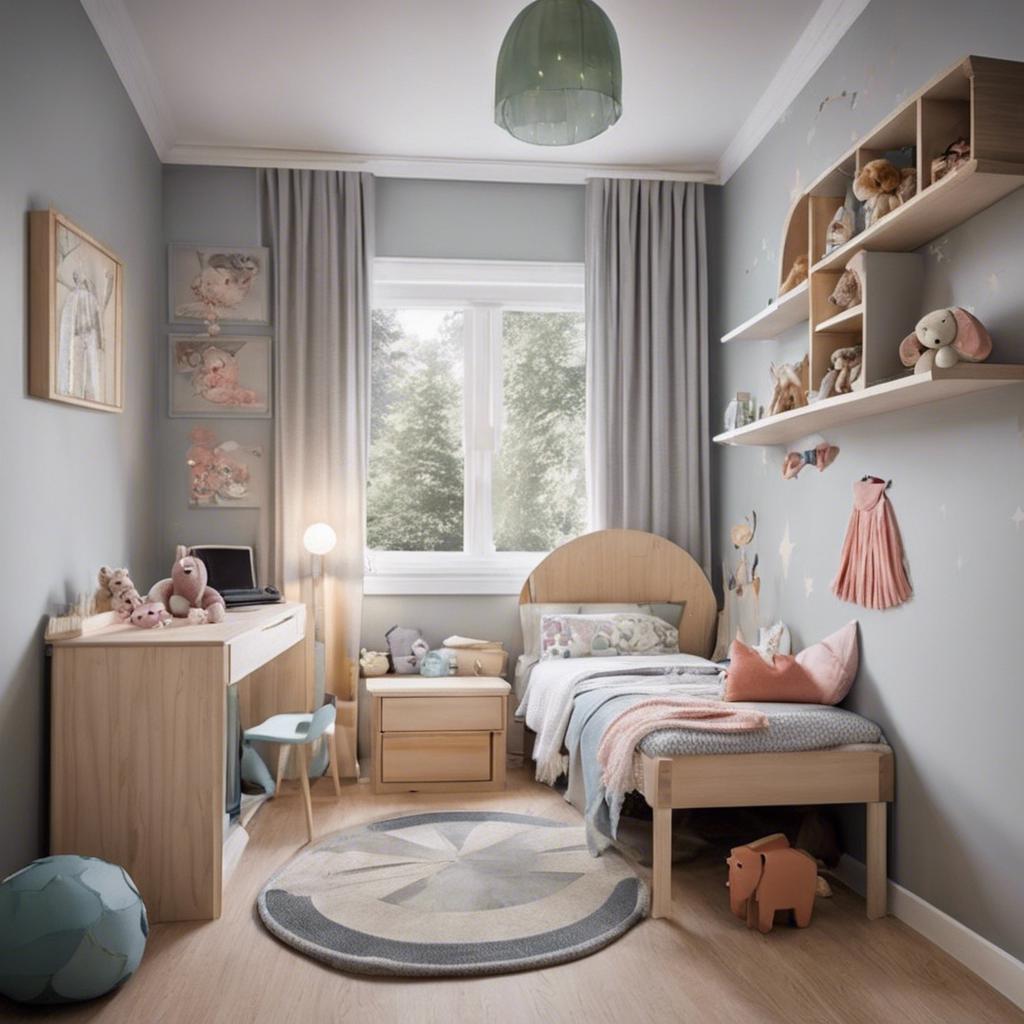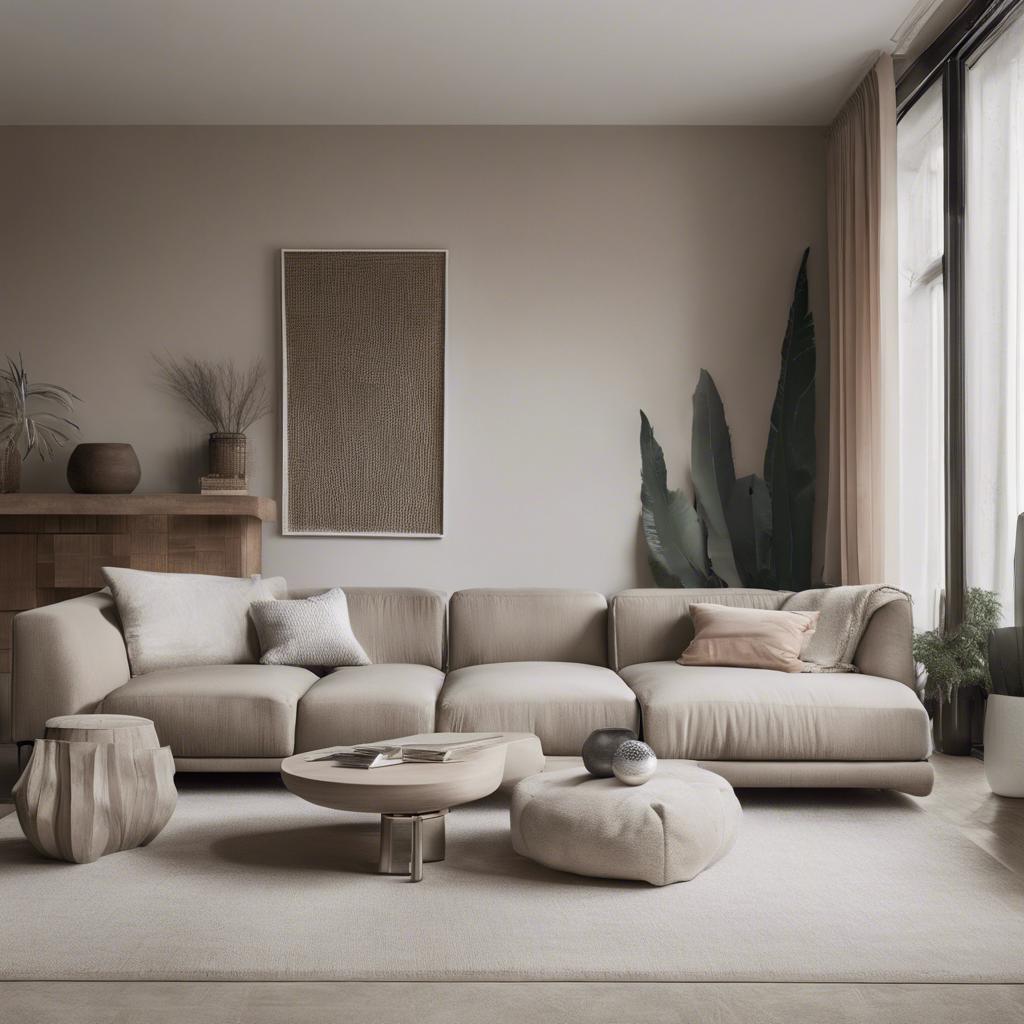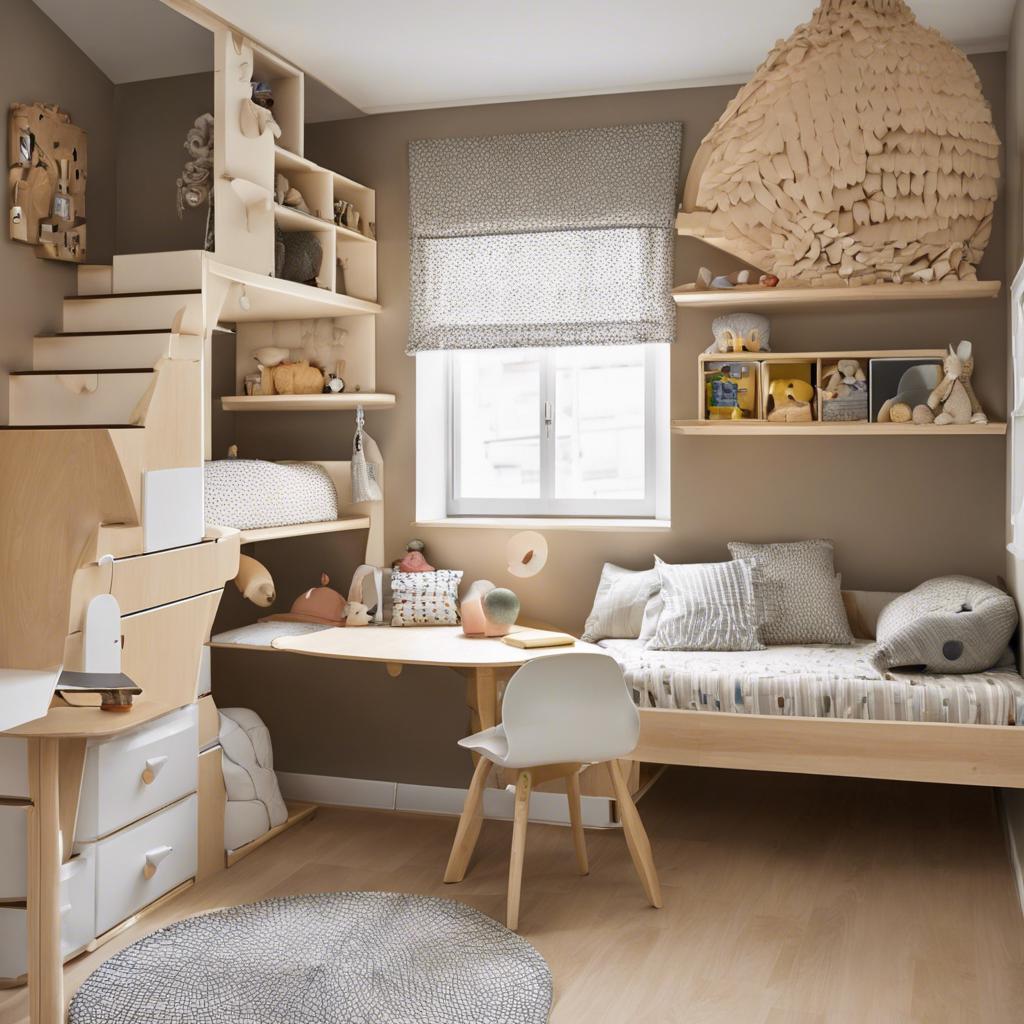In a world where imagination knows no bounds, a child’s bedroom serves as the canvas for dreams, adventures, and a myriad of colorful possibilities. It is within these enchanting spaces that young minds flourish, each corner carefully curated to inspire creativity and comfort. Designing a room for a child is not merely about decorating; it’s about crafting a sanctuary that reflects their unique personality, nurtures their interests, and adapts as they grow. Whether you’re diving into whimsical themes or embracing practical solutions, this article explores a range of creative design ideas that transform ordinary rooms into extraordinary realms of play and learning. Join us as we journey through the art of designing spaces that captivate both the young and the young-at-heart, ensuring every child’s room is a delightful reflection of their vibrant spirit.
Enchanting Elements for a Small Kids Room
Transforming a small kids’ room into a magical haven can be achieved with a few enchanting elements. Whimsical wall decals can instantly bring any bedroom to life, whether it’s a starry night sky, a forest fairy tale, or a favorite character. Opt for removable stickers that allow for easy changes as your child’s interests evolve. To complement these visuals, consider adding soft lighting options like fairy lights or a whimsical night lamp that casts playful shadows, creating a cozy and inviting atmosphere.
Incorporating multi-functional furniture is also key in maximizing space while ensuring it remains playful. Choose beds with built-in storage, or maybe a desk that can double as a crafting table. Layering textures with colorful rugs can define areas within the room, promoting both play and study. Lastly, create a display zone for toys and books that embodies creativity; open shelves or a colorful book nook encourage independence and inspire imagination.
Color Palette Choices That Inspire Imagination
For those seeking to create a more dynamic space, think about layering colors through a combination of bold accents and subtle undertones. Here are some effective combinations to inspire your palette:
- Coral and teal: A modern twist that excites and uplifts.
- Purple and gold: Evokes a sense of whimsy, perfect for fairy tale themes.
- Tangerine and ocean blue: Energetic and refreshing, great for adventure seekers.
- Muted greys with splashes of neon: A chic, contemporary approach.
| Color Combination | Feelings Conveyed |
|---|---|
| Coral + Teal | Joyful energy |
| Purple + Gold | Whimsy & fantasy |
| Tangerine + Ocean Blue | Vibrant adventure |
| Muted Greys + Neon Accents | Modern sophistication |
Ultimately, the best color choices for a child’s room are those that reflect their personality and interests. As you curate your palette, remember to blend hues that inspire creativity and provide a sense of comfort. Whether you choose to embrace boldness or strive for calm, the colors around them can unfold the stories and dreams that fill their imagination.
The Magic of Themed Decor in a Small Kids Room
Transforming a small kids room into a captivating oasis is easier than you might think with themed decor. By selecting a theme that resonates with your child’s interests, you can create an environment that is both functional and whimsical. Consider the possibilities of using a color palette tailored to the theme, along with thematic wall decals or stencils, which can instantly elevate the visual appeal of the room. For example, a space theme might feature stars and planets on the walls, while a fairytale theme could incorporate enchanting forest creatures hidden among delicate trees. Each corner of the room can tell a story and inspire imaginative play, making it a truly magical space.
Incorporating themed decor can also optimize the limited space in a small room. Utilize multi-functional furniture adorned with thematic elements, such as a bed with built-in storage that features the child’s favorite characters or a play table decorated to resemble a pirate ship. Additionally, pay attention to the textiles and accessories; choose bedding, curtains, and rugs that reflect the chosen theme while being practical for everyday use. A well-thought-out space not only excites little imaginations but also promotes organization and efficiency, ensuring that the room remains a joy to both children and parents alike.
Functional Furniture Solutions for Small Spaces
- Bunk Beds with Storage: Utilize vertical space by opting for bunk beds that come with built-in drawers or shelves underneath.
- Convertible Desks: Choose desks that fold away or expand as needed, providing a study area that doesn’t sacrifice floor space.
- Ottomans with Hidden Storage: Use ottomans that double as toy boxes, keeping the room tidy while providing extra seating.
- Wall-Mounted Shelves: Incorporate shelves mounted to the wall for books and decor, freeing up precious floor space.
To further enhance the functionality of your child’s room, think about arrangements that promote organization and accessibility. Implementing designated zones for play, sleep, and study can help the room feel more cohesive. Here’s a simple layout suggestion:
| Zone | Furniture Suggestions |
|---|---|
| Play Area | Rug with storage baskets |
| Sleeping Area | Bunk bed with integrated storage |
| Study Corner | Foldable desk and a colorful chair |
Incorporating Nature into Small Kids Room Design
Creating a whimsical environment that embraces the beauty of the outdoors can greatly enhance a child’s imagination and well-being. Incorporating elements from nature—such as natural materials, themed colors, and organic shapes—can transform a small kids’ room into a refreshing sanctuary. Here are some ideas to consider:
- Wooden Furniture: Choose pieces made from sustainable materials, like bamboo or reclaimed wood, which bring warmth and simplicity into the space.
- Nature-Inspired Textiles: Opt for bedding and curtains featuring floral or wildlife motifs to weave a narrative of the forest or garden into their daily lives.
- Indoor Plants: Incorporate kid-friendly plants such as spider plants or pothos, teaching little ones about responsibility while brightening up their room.
To truly evoke the essence of nature, color choices can play a pivotal role in setting the mood. Earthy tones, such as soft greens, creamy whites, and muted browns, create a serene atmosphere reminiscent of a peaceful outdoor landscape. Here’s a simple color palette idea:
| Color | Meaning | Use |
|---|---|---|
| Soft Green | Calming | Accent walls or decor |
| Creamy White | Brightening | Ceiling and trim |
| Muted Blue | Trust | Furniture and accessories |
Wall Art Ideas to Spark Creativity in Small Kids Rooms
Transforming a small kids’ room into an imaginative haven can be as simple as carefully curated wall art that ignites their creativity. Start by exploring the theme of the room, then select a variety of vibrant prints that reflect their interests. Consider mixing and matching different styles, such as:
- Whimsical illustrations that tell a story
- Educational posters featuring the alphabet or planets
- Personalized canvases showcasing their name or favorite quote
- Textured art with felt or wood to add depth
To add a playful touch, create a gallery wall by framing artwork in mismatched frames and arranging them in an asymmetrical design. Incorporating magnetic boards or cork boards allows for easy swapping of their own creations, providing a space for self-expression. Consider using a simple table format to outline the key elements for your wall art selection:
| Art Element | Purpose | Suggested Style |
|---|---|---|
| Illustrations | Stimulate imagination | Colorful and fun |
| Posters | Educational value | Bold colors |
| Gallery wall | Personal expression | Mismatched frames |
| Interactive boards | Encourage creativity | Functional designs |
Transforming Small Kids Rooms with Multi-Purpose Areas
Creating a room that serves multiple functions can elevate any small space, especially in a child’s bedroom. Imagine a vibrant room where the bed transforms into a cozy reading nook during the day; with creative furniture solutions, the possibilities are endless. Consider incorporating components such as:
- Lofted Beds – Frees up floor space for play or study.
- Foldable Desks - Can be tucked away when not in use, maximizing space.
- Storage Benches - Ideal for toy storage while providing extra seating.
Think about combining areas where creativity meets functionality. For instance, a wall-mounted art board can double as a display area for both finished projects and imaginative doodles, harmonizing art and organization seamlessly. Additionally, using vibrant colors and thematic decor can help different sections of the room feel distinct yet complementary. A simple table can serve as both a crafting corner and a homework hub, encouraging creativity and productivity side by side. Here’s a table showcasing multifunctional furniture ideas:
| Furniture Type | Functionality |
|---|---|
| Convertible Crib | Transforms into a toddler bed as the child grows. |
| Wall-Mounted Desk | Flips down for studying and folds up for a cleaner look. |
| Storage Ottomans | Acts as seating while safely storing books or toys. |
Playful Lighting Fixtures for a Cozy Atmosphere
Lighting can transform a child’s room into a magical haven, making it not only functional but also inviting. Consider incorporating fixtures that serve as delightful focal points, creating a warmth that wraps around the space. Examples of such fixtures include:
- Starry Night Projectors: Project captivating star patterns on the walls and ceiling for a celestial experience.
- Animal-shaped Lamps: From quirky owls to playful elephants, these lamps add a whimsical touch.
- Colorful String Lights: Drape them around the bed or window to create a cozy, twinkling atmosphere.
To enhance the playful ambiance, consider using light fixtures that change color or brightness according to the child’s mood or activity. A table below outlines some fantastic options that beautifully blend functionality with fanciful design:
| Fixture Type | Features | Best For |
|---|---|---|
| LED Night Light | Soft glow, multiple colors | Bedtime comfort |
| Cactus Lamp | Unique design, eco-friendly | Themed decor |
| Cloud Pendant Light | Fluffy design, gentle light | Creative ambiance |
Stylish Storage Options for Clutter-Free Small Kids Rooms
Transform the chaos of toys and clothes into a haven of style with creative storage solutions tailored for small spaces. Consider using multi-functional furniture that combines seating and storage, such as benches with hidden compartments or ottomans that can double as toy boxes. Wall-mounted shelves not only save floor space but can also be adorned with colorful bins or baskets for an aesthetically pleasing organization system. Incorporate a readily accessible library corner using low-height bookshelves that invite kids to reach for their favorite stories while keeping the room tidy.
Another innovative approach is embracing the use of vertical space by integrating hanging organizers. These could be fabric pockets or mesh bags that can easily hold smaller items, like art supplies or plush toys. Use hooks or pegboards to hang backpacks, hats, and even art creations, turning functional storage into a part of the decor. For a charming touch, tables with built-in drawers can cleverly conceal items while remaining stylish. The goal is to create a playful yet organized environment where each piece serves a purpose while keeping clutter at bay.
Creating a Reading Nook in a Small Kids Room
Transforming a small corner of your child’s room into a cozy reading nook can cultivate a love for books while providing a personal retreat. Start with a compact reading chair or a floor cushion to create a soft seating area. Surround the nook with a few small shelves or a reading cart stocked with your child’s favorite stories. For added charm, drape colorful fairy lights or a whimsical canopy overhead to invite a sense of magic. Consider using a small side table for a nightlight or a place to set a cup of warm cocoa. This special area can quickly become a cherished retreat for both reading and imaginative play.
Adding personal touches will enhance the nook’s appeal. Incorporate cushions in fun shapes or colors that resonate with your child’s interests, such as animals, superheroes, or princesses. You might even introduce a mini bulletin board to showcase their latest art or favorite quotes from beloved books. To keep the space organized, use labeled baskets or bins to hold extra books and blankets. Establishing a reading corner that caters to your child’s tastes not only nurtures their reading habits but also imbues their room with a sense of creativity and wonder.
Flooring Ideas That Enhance Comfort and Safety
When designing a cozy and secure environment for children, the choice of flooring plays a pivotal role. Soft, cushioned surfaces can help prevent injuries and add warmth to any vibrant room. Here are some ideal flooring options that combine comfort with safety:
- Carpet Tiles: Easy to install and replace, they provide a soft landing for little feet while allowing for fun patterns.
- Vinyl Flooring: Durable and water-resistant, it’s available in numerous designs that can mimic wood or tile.
- Foam Mats: Perfect for play areas, these mats are cushioned and can be arranged in various configurations to spark creativity.
- Natural Fibers: Rugs made from jute or sisal are eco-friendly and provide a soft texture underfoot, perfect for adventurous play.
Additionally, ensuring the flooring is slip-resistant can significantly enhance safety in kids’ rooms. Consider incorporating transition strips for doorways, which can help to minimize tripping hazards. Below is a simple overview of features to evaluate when selecting flooring:
| Flooring Type | Comfort Level | Safety Features |
|---|---|---|
| Carpet Tiles | High | Soft, non-slip |
| Vinyl Flooring | Medium | Water-resistant, low-slip |
| Foam Mats | High | Cushioned, shock-absorbent |
| Natural Fibers | Medium | Textured grip |
Personalized Touches That Make a Small Kids Room Unique
Injecting a sense of personality into a child’s room transforms it from a simple sleeping space into a magical retreat. Wall decals featuring whimsical characters or vibrant themes can instantly uplift the decor. Consider creating a gallery wall by framing your child’s artwork, which not only showcases their creativity but also makes them feel like a budding artist. Incorporating custom bedding with their favorite colors or characters further personalizes the space while ensuring comfort. Adding themed curtains can tie the whole look together while introducing enchanting patterns that inspire dreams and adventures.
To enhance the room’s uniqueness, think about integrating functional decor items that also serve as learning tools. For example, a playful alphabet rug not only provides a soft play area but also helps with letter recognition. Consider using storage solutions that resonate with your child’s interests—a treasure chest for toys or a bookshelf shaped like a rocket. You can also create a cozy reading nook with a small bean bag, vibrant cushions, and shelves displaying beloved books. Keep in mind that a variety of textures and materials enrich the sensory experience, making the room an inviting space for exploration and imaginative play.
Creative Use of Vertical Space in Small Kids Rooms
Maximizing vertical space in your little one’s room can transform it into a whimsical haven. Consider installing floating shelves that showcase toys, storybooks, and delightful decor. These shelves not only save floor space but can also be arranged in playful patterns that create visual interest. Incorporating a tall bookcase can provide ample storage for both books and decorative items, while allowing the floor to remain clear for play. Add a touch of fun with colorful bins or boxes on the shelves, encouraging children to keep their space tidy while enjoying the aesthetic.
Another inventive solution is to utilize vertical wall-mounted elements. Hooks and pegboards can turn walls into interactive spaces where kids can hang their favorite costumes or art supplies, fostering creativity and independence. For a cozy reading nook, consider a hammock chair or a swing that can be suspended near the ceiling, giving children a playful spot to unwind. A simple yet stylish wall mural or decals extending upwards can also enhance the room’s charm, telling a story that sparks the imagination and makes the best use of every inch of the walls.
Dreamy Bedding Ideas for a Vibrant Small Kids Room
Transform your small child’s sanctuary into an enchanting retreat with imaginative bedding options that spark creativity and comfort. Opt for colorful duvet covers adorned with whimsical patterns—think playful animals, vibrant rainbows, or fairy tale scenes. These designs not only bring joy but also colorfully define the space. Pair them with soft, fluffy throw pillows in contrasting shades to create a cozy reading nook that invites exploration and playful adventures. Layering various textures—like a fuzzy blanket or a knitted throw—will enhance the bedding aesthetic, making the area both stylish and snug.
For a unique touch, consider mixing and matching themes to create a vibrant collage of designs. Choose sheets with polka dots and a quilt featuring a landscape, adding a bit of magic to the room. Incorporate bed skirts in bold colors to tie the look together, providing a sense of cohesion amidst the playful chaos. To elevate the ambiance further, hang fairy lights above the bed or use a mobile featuring stars or fluffy clouds, complementing the bedding theme and creating a dreamy nighttime vibe.
Inspiration from Around the World for Small Kids Room Designs
Exploring Mexican aesthetics brings bold colors and dynamic patterns to life. Think about bright murals with whimsical motifs, handcrafted textiles, and decorative elements that celebrate local folklore. For a sprinkle of bohemian charm, mix and match various prints and textures from around the globe. Hanging dreamcatchers, bright rugs, and a tent-shaped reading nook can make the room both cozy and inspiring. Remember to showcase interactive spaces, like a world map mural, where children can learn about different countries, promoting curiosity and creativity.
DIY Projects to Add Charm to Small Kids Rooms
Transforming a small kid’s room into a charming retreat can be an exciting venture, especially with the right DIY projects. One delightful idea is to create themed wall decals that resonate with your child’s interests. These can be made from colorful cardstock or removable vinyl, allowing for easy updates as their tastes evolve. Combining different shapes, such as stars, animals, or floral motifs, can turn a plain wall into a stunning focal point. To enhance the space further, consider crafting a custom mural by painting a whimsical scene or by using stencils that reflect your child’s favorite storybook characters. This interactive element not only boosts creativity but also serves as a fantastic conversation starter.
Another accessible yet impactful project is to enhance storage solutions with charm and functionality. A simple floating shelf can be installed to display books, toys, or artwork, giving the room a tidy appearance while showcasing personal treasures. You can make the shelves more enchanting by painting them in vibrant colors or using patterned contact paper. Additionally, creating personalized storage bins from upcycled materials such as cardboard boxes or wooden crates can add character. Decorate them with stickers, washi tape, or paint to fit the room’s theme. For a touch of whimsy, consider using a hanging organizer made from fabric, which can store smaller items while simultaneously acting as a decorative element against the wall.
Fun and Functional Play Zones in Small Spaces
Transforming a compact area into an imaginative play zone can be both challenging and rewarding. Start by utilizing multi-functional furniture that can serve dual purposes, such as a bench that doubles as a storage unit. Look for vibrant, modular shelving that allows for easy access to toys and books while adding a pop of color to the room. These shelves can be arranged in playful patterns, creating an interactive space for little ones to explore and enjoy. Incorporate a cozy reading nook with oversized cushions or a small bean bag, perfect for storytime or quiet reflection.
Incorporate creative wall designs to maximize vertical space. Consider using decals to design a world map or a whimsical jungle, inviting children’s imaginations to roam freely. Adding a chalkboard wall not only sparks creativity but also serves as a canvas for their latest masterpieces. Use lightweight, portable play equipment like a small tent or tunnel to create an ever-changing landscape of adventures. Rotating these elements can keep the area fresh and exciting, ensuring that each playtime brings new experiences and discoveries.
Setting Up a Homework Station in a Small Kids Room
Creating a dedicated homework station in a small kids’ room can transform an ordinary space into a productive haven. To begin, choose a corner that receives good lighting, using natural light whenever possible to brighten the workspace. Incorporate a small desk that fits snugly against the wall, perhaps with a fun and colorful chair to keep the area inviting. Maximize storage with wall-mounted shelves that can house books, supplies, and personal touches, like artwork or inspiring quotes. This setup not only saves space but also encourages kids to keep their materials organized and accessible.
Enhancing the atmosphere is key to promoting creativity and focus. Consider implementing decorative elements that resonate with your child’s interests—think vibrant colors, playful patterns, or themed accessories. Use organizational tools like colorful baskets and labeled bins to categorize items effectively. A small chalkboard or corkboard can serve as both a bulletin board for reminders and a canvas for doodling ideas. Below is a simple overview of essential items to include in the homework station:
| Item | Purpose |
|---|---|
| Small Desk | Designated workspace for studying |
| Colorful Chair | Encourages comfort and creativity |
| Wall Shelves | Storage for books and supplies |
| Baskets & Bins | Organization of materials |
| Chalkboard/Corkboard | Visual aid for notes and creativity |
Tips for Choosing Accessories in a Small Kids Room
When designing a small kids’ room, selecting the right accessories can enhance both functionality and flair. Begin by considering the color palette; accessories should complement the main hues of the room without overwhelming it. Opt for multi-functional pieces like storage ottomans or playful wall hooks that invite creativity while keeping chaos at bay. Don’t shy away from using whimsical designs—think fun animal motifs, stars, or vibrant patterns—that can easily be swapped out as your child’s tastes develop.
Think beyond traditional decor to incorporate interactive elements that stimulate play and imagination. Add a small reading nook with a colorful bean bag, where books can double as decor with a charming bookshelf. Consider using removable wall decals to create a storybook atmosphere that can evolve over time, keeping it fresh and exciting. When placing accessories, remember to hang art and shelves at your child’s eye level to encourage exploration, making the room a personal oasis for creativity and adventure.
Creating a Harmonious Space with Soft Textures
Transforming a child’s room into a cozy nook involves incorporating soft textures that invite playfulness and comfort. Plush rugs in vibrant colors can add warmth underfoot, making the space inviting for young explorers. Layered textiles, such as quilted bedspreads paired with fluffy pillows, create a sense of snugness while offering various tactile experiences. Opt for curtains made from light, airy fabrics to nurture a bright atmosphere, yet also provide a soft barrier against the outside world, perfect for afternoon naps or quiet reading time.
When choosing furniture and decor, consider pieces that possess a soft touch, such as bean bags, surfaces with rounded edges, and cushioned benches. Combining these elements can enhance the room’s functionality and aesthetics. Add a soft throw blanket draped over a chair or bed to encourage relaxation and warmth. To emphasize a harmonious look, select a color palette that is easy on the eyes—think pastel shades or earthy tones that harmonize beautifully with the textures. Here’s a quick summary of ideal soft texture elements:
| Element | Description |
|---|---|
| Rugs | Plush, vibrant, and colorful to warm up the flooring. |
| Textiles | Quilts and fluffy pillows that enhance comfort. |
| Curtains | Light fabrics that let in natural light while offering privacy. |
| Furniture | Cushioned, soft-touch pieces with rounded edges. |
Mixing Vintage and Modern Styles in Small Kids Rooms
Creating a harmonious blend of vintage and modern styles in small kids’ rooms can foster a unique and delightful atmosphere. One way to achieve this mix is by selecting key vintage pieces, such as a charming antique dresser or retro rocking chair, and pairing them with sleek, contemporary furniture. This juxtaposition can create a playful yet sophisticated look that grows with your child. To add an extra layer of texture and interest, consider using fabrics like macramé wall hangings or patterned quilts that incorporate both vintage and modern designs.
Color is an essential element in combining these styles. A carefully curated palette can help bridge the gap between the old and the new. Consider the following tips to enhance the space:
- Accent Wall: Use vintage wallpaper on one wall while keeping the others a solid, modern color.
- Mix Patterns: Combine geometric patterns with florals to create visual intrigue.
- Decorative Accents: Incorporate vintage toys or bookends alongside sleek modern light fixtures.
Here’s a simple table showcasing some vintage and modern pieces that work harmoniously together:
| Vintage Piece | Modern Counterpart |
|---|---|
| Wooden Rocking Horse | Minimalist Metal Chair |
| Classic Bookcase | Floating Shelves |
| Patchwork Quilt | Solid Color Duvet |
By thoughtfully selecting and arranging a mix of furniture, accents, and colors, you can create a small kids’ room that captivates the imagination without sacrificing functionality.
Safety Tips for Designing a Small Kids Room
Creating a small kids room can be an exciting challenge, but safety should always be the top priority. To ensure a secure environment, consider using rounded furniture with soft edges and sturdy materials. Incorporate storage solutions that are easily accessible yet out of reach for small hands, such as wall-mounted shelves or drawers. Ensure that heavy furniture items are anchored to the wall to prevent tipping during playtime. Additionally, choose non-toxic paints and finishes to protect your child’s health while they explore their enchanting space.
Lighting is another crucial factor in designing a safe kids room. Opt for soft, diffused lighting that prevents harsh shadows and helps create a cozy atmosphere. Use night lights with cool-to-the-touch designs to ensure safety during bedtime. It’s also wise to install outlets with safety covers and avoid using extension cords where possible. To further enhance safety, consider including a small table for crafts that has a wipeable surface, setting the stage for creativity without the worry of messes becoming hazards.
Adapting Designs as Your Child Grows in a Small Space
As your child grows, their interests and needs evolve, making it essential to adapt their room without compromising on style, especially in a small space. To achieve this, consider incorporating multifunctional furniture that can serve multiple purposes. For instance, a bed with built-in storage can hold toys or clothes, while a desk that folds down can provide a work area without taking up too much room. Additionally, utilizing vertical space with shelves allows for displaying cherished items like awards or art, creating a personalized touch. Here are some clever ideas:
- Use adjustable shelving: Perfect for holding books or decorative items, and can be moved as needs change.
- Incorporate a growing desk: A desk that adjusts in height can accommodate your child from toddler to teen years.
- Add a canopy: A simple fabric canopy can transform a bed into a cozy nook, inviting imaginative play.
When planning for growth, consider flexible color schemes and themes that can be easily updated. Neutral base colors allow for the incorporation of colorful elements that can be changed with minimal effort. For example, rather than painting a mural, opt for removable wall decals that can be switched out with your child’s changing interests. Additionally, consider the layout—allowing space for activities like reading or crafting ensures that the room remains functional as your child’s hobbies evolve. Below is a quick overview:
| Age Group | Design Focus | Adaptation Ideas |
|---|---|---|
| Toddler | Safety & Play | Soft edges, toy storage. |
| Preschool | Imagination | Thematic décor, play areas. |
| School Age | Functionality | Homework space, organization. |
| Teen | Personality | Personalized art, privacy. |
Q&A
Q&A: Enchanting Spaces: Creative Design Ideas for Kids’ Rooms
Q1: What are some key elements to consider when designing a kid’s room?
A1: When designing a kid’s room, it’s crucial to prioritize flexibility and functionality. Consider incorporating multifunctional furniture, such as beds with storage drawers or desks that can adapt as your child grows. Additionally, think about the theme or interests of your child—whether it’s space exploration, nature, or a favorite storybook. This will help you create a cohesive and engaging environment. Remember to include plenty of storage options to keep the space organized and clutter-free.
Q2: How can parents introduce a sense of playfulness into the room design?
A2: Playfulness can be woven into a room through bold colors, whimsical patterns, and imaginative decor. Consider painting an accent wall in a bright hue or using removable wallpaper featuring playful designs. Adding fun elements like a climbing wall, a tent for reading nooks, or a chalkboard wall can encourage creativity and play. Accessories like funky rugs, vibrant cushions, and unique light fixtures can also add a playful touch to the overall design.
Q3: What role do colors play in a child’s room, and what palettes are recommended?
A3: Colors significantly impact mood and creativity. For a tranquil atmosphere, softer pastels like mint green, lavender, or pale peach can encourage relaxation. For a more stimulating effect, bolder colors like emerald green, sunshine yellow, or deep blue can ignite energy and imagination. A balanced approach, utilizing a combination of calming and invigorating colors, can create a dynamic space that evolves with your child’s mood and activities.
Q4: How can parents balance aesthetics with practicality in a kid’s room?
A4: Balancing aesthetics with practicality involves choosing durable and easily cleanable materials, as well as versatile designs. Opt for furniture with rounded edges and modular components that can be rearranged as needed. Adding elements like washable fabrics and easy-to-access storage will ensure that the space not only looks good but also serves everyday needs. Keeping the design adaptable allows you to rearrange as your child’s interests develop over time.
Q5: Are there budget-friendly ways to create enchanting spaces?
A5: Absolutely! Thrift stores, flea markets, and DIY projects can be fantastic sources for unique and budget-friendly decor. Upcycling old furniture with a fresh coat of paint or swapping out hardware can give new life to timeless pieces. DIY wall art and custom shelves can add personality without breaking the bank. Additionally, hosting a swap party with friends for toys or decor can refresh the room at minimal cost.
Q6: What are some innovative storage solutions for kids’ rooms?
A6: Innovative storage solutions include using under-bed storage bins, wall-mounted shelves, and over-the-door organizers. Consider colorful, labeled bins to encourage kids to tidy up while adding a pop of color. Utilizing vertical space not only maximizes storage but also creates an appealing aesthetic. Incorporating furniture that doubles as storage, like ottomans or benches with compartments, can further enhance the functionality of the room.
Q7: How can kids get involved in the design process?
A7: Involving kids in the design process can foster a sense of ownership and pride in their space. Encourage them to express their ideas and preferences by letting them choose colors, themes, or artwork they love. Providing opportunities for them to help with DIY projects can spark creativity. Set up a mood board together with magazines and fabric swatches to visualize their dream room, making the design process a shared adventure.
Q8: What final touches can make a kid’s room truly enchanting?
A8: Final touches like personalized wall art or framed photos can make the room feel uniquely theirs. Adding soft lighting options, like fairy lights or a whimsical night lamp, can create a cozy atmosphere. Incorporate plants or nature-inspired elements for a refreshing touch. Lastly, including a special reading corner with cushions and a well-curated bookshelf can encourage relaxation and an enduring love for books, making the space as enchanting as it is functional.
The Way Forward
transforming a child’s room into an enchanting space is both a delightful challenge and a rewarding journey. By weaving creativity with practicality, these design ideas can spark imagination, foster independence, and create a sanctuary that reflects your child’s personality and interests. Remember, the heart of a magical room lies not just in its aesthetics, but in how it nurtures growth and exploration. So gather your tools, unleash your creativity, and embark on an adventure where dreams take form and every corner of the room holds the promise of discovery. With a little imagination and a pinch of inspiration, you can craft a haven that your child will cherish for years to come. Happy designing!
As an Amazon Associate I earn from qualifying purchases.
 decorafit.com Design ideas for your home and patio
decorafit.com Design ideas for your home and patio
